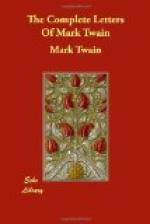I am re-reading Ticknor’s diary, and am charmed with it, though I still say he refers to too many good things when he could just as well have told them. Think of the man traveling 8 days in convoy and familiar intercourse with a band of outlaws through the mountain fastnesses of Spain—he the fourth stranger they had encountered in thirty years—and compressing this priceless experience into a single colorless paragraph of his diary! They spun yarns to this unworthy devil, too.
I wrote you a very long letter a day or two ago, but Susy Crane wanted to make a copy of it to keep, so it has not gone yet. It may go today, possibly.
We unite in warm regards to you and yours.
Yrs
ever,
mark.
The Ticknor referred to in a former letter was Professor George Ticknor, of Harvard College, a history-writer of distinction. On the margin of the “Diary” Mark Twain once wrote, “Ticknor is a Millet, who makes all men fall in love with him.” And adds: “Millet was the cause of lovable qualities in people, and then he admired and loved those persons for the very qualities which he (without knowing it) had created in them. Perhaps it would be strictly truer of these two men to say that they bore within them the divine something in whose presence the evil in people fled away and hid itself, while all that was good in them came spontaneously forward out of the forgotten walls and comers in their systems where it was accustomed to hide.”
It is Frank Millet, the artist, he is speaking of—a knightly soul whom all the Clemens household loved, and who would one day meet his knightly end with those other brave men that found death together when the Titanic went down.
The Clemens family was still at Quarry Farm at the end of August, and one afternoon there occurred a startling incident which Mark Twain thought worth setting down in practically duplicate letters to Howells and to Dr. John Brown. It may be of interest to the reader to know that John T. Lewis, the colored man mentioned, lived to a good old age—a pensioner of the Clemens family and, in the course of time, of H. H. Rogers. Howells’s letter follows. It is the “very long letter” referred to in the foregoing.
To W. D. Howells and wife, in Boston:
Elmira, Aug. 25 ’77. My dear Howellses,—I thought I ought to make a sort of record of it for further reference; the pleasantest way to do that would be to write it to somebody; but that somebody would let it leak into print and that we wish to avoid. The Howellses would be safe—so let us tell the Howellses about it.
Day before yesterday was a fine summer day away up here on the summit. Aunt Marsh and Cousin May Marsh were here visiting Susie Crane and Livy at our farmhouse. By and by mother Langdon came up the hill in the “high carriage” with Nora the nurse and little Jervis (Charley Langdon’s little boy)—Timothy the coachman driving. Behind these came Charley’s wife and little girl in the buggy, with the new, young, spry, gray horse—a high-stepper. Theodore Crane arrived a little later.




